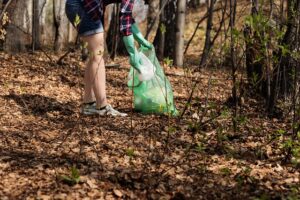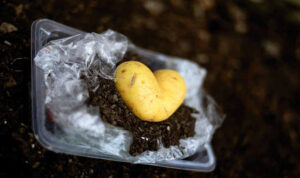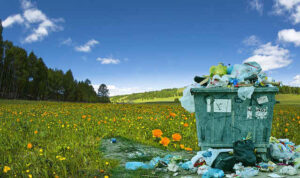10 Shocking Evidence Proves How Harmful Plastic Is to Our Planet: Plastic is a material that has been used for decades and it has become a major part of our lives. It is present in almost every aspect of our lives. Plastic water bottles, plastic bags, plastic containers, etc.
Plastics are not biodegradable and they do not break down into smaller pieces which means that they will remain on the earth for centuries to come. This is one of the main reasons why plastics are so harmful to the environment because there is no way for them to decompose.
1. There Could Be More Plastic Than Fish in The Ocean By 2050
According to an Ellen Mac Arthur Foundation report, only 14% of harmful plastic is being collected for recycling. In contrast, 86% is left on the environment and is washed away to the marine and dry land. The plastics are then disposed of in the environment and ocean, causing extreme plastic pollution. Since plastic is still majorly used globally, it is expected that its production rate will double in the next two decades. The report states that due to the estimated plastic pollution by 2050, stakeholders must initiate projects that encourage recycling and avoid plastics to the environment.
2. 2.8 Billion Tons of Greenhouse Gases Could Be Released into The Atmosphere By 2050
The extraction, transportation and manufacturing of fossil fuels to create plastics lead to billions of tones of greenhouse gases which is a significant cause of global warming. In an interview, Kerri Major from World Wide Fund for Nature, Australia, states that in 2019, an estimated 850 million tonnes of greenhouse gases are released to the environment, and this could increase to 2.8 billion tonnes by 2050. The fossil fuels emitted into the atmosphere cause significant risks, such as global warming, destroying the earth. Action needs to be taken to prevent greenhouse gases from being emitted into the environment to save our planet.
3. Plastics Take 400-1000 Years to Decompose
The Guardian estimates that while humans and other animals take approximately 40-100 years to degrade, plastics take 400-1000 years, causing litter to landfills and the environment for generations. The environment will have 12 billion tons of plastic waste in the environment by 2050. Plastics take very long to decompose, yet they are continually being produced, used and disposed of inappropriately; they are a great danger to our planet. In this regard, recycling and using decomposing materials should instead be used to prevent plastic pollution.
4. 1million Seabirds, 100k Marine Animals and Turtles, Are at Risk of Death Caused by Harmful Plastics
Ingestion and entanglement in harmful plastic have contributed to many marine and sea birds’ death due to plastics pollution in the water body. 50-80% of turtle death have been caused by plastic pollution endangering the turtle species. Two Ocean Aquarium states that some of the endangered turtles have been rescued after plastic bags were removed from the animals’ throats and digestive system. Some marine animals have also been rescued after being stranded or entangled by harmful plastics in the water bodies.
5. Dryland Has 4 To 23 More Microplastics Than Marine.
Researchers warn that microplastics pollution has long-term effects worldwide, with dry land having 4 to 23 more microplastics than marine. Microplastics disintegrate into tiny particles, which then enter the food chain, causing toxicity to the soil. These microplastics also integrate into the planets through the soil, and when consumed by plants and animals, they result in damaging health effects. According to a study conducted in America, depending on age and sex, microplastics’ consumption is estimated to be between 39,000 and 52,000 particles yearly. This Shocking Evidence Proves How Harmful Plastic Is to Our Planet.
6. 17.6 Billion Tons of Plastic Enter the Ocean Every Year.
According to OCEANA, the waste can be compared to a truck full of plastic garbage dumped in the ocean every minute due to increased plastic production and low recycling rate, hence pilling plastic waste. This harmful plastic releases toxic substances into the water leading to the destruction of marine life. Marine food like algae attach themselves to plastics, and marine life ends up ingesting them, affecting their digestive systems. This Shocking Evidence Proves How Harmful Plastic Is to Our Planet.
7. Chemical Emissions by Plastics Adversely Affect Human Health
According to the Center for International Environmental Law, over 170 chemicals used in plastic production have harmful health effects on humans working in the industries or living near the production sites. These toxic chemical emissions get to animal and human bodies through inhalation or ingestion through contaminated food. The toxins have diverse effects on human organs, including the eyes, brain, kidney, liver, respiratory, and digestive system, resulting in the deaths of millions of human beings globally. This Shocking Evidence Proves How Harmful Plastic Is to Our Planet.
8. So Much Water Is Used in The Manufacture Of Plastics.
The Water Footprint Calculator states that it takes 22 gallons of water to manufacture a pound of plastic. Making a water bottle takes at least 44 gallons of water. Since plastics affect all living organisms on the planet, both in water and on land, this water would have been best used for other vital purposes, such as irrigating crops to increase productivity. Channelling the water used for making plastics towards more sustainable and beneficial projects leads to improved value of life. This Shocking Evidence Proves How Harmful Plastic Is to Our Planet.
9. Trillions of People Purchase and Use Plastic Bags Globally.
Four trillion plastic bags are bought and used annually, with only 1% of them recycled. According to Earth Day 2018, ending plastic pollution states that 1million plastic bottles are bought every minute by humans globally. Plastic bags are mainly used to globally carry shopping items from malls or markets, leading to their very high demand. Plastic bags are also used to carry waste materials from homes to dumping sites. This Shocking Evidence Proves How Harmful Plastic Is to Our Planet.
10. Global Revenue Loss by Tourism Industry Due to Plastic Pollution
An estimated 80% of tourism happens along the coastal regions globally. The tourism sector has been affected by harmful plastic due to plastic papers and bottles on the shores and beaches of oceans and other water bodies, which are great tourist attractions worldwide. According to Water Witch states in just one year, $37 million revenue was lost by South Korea in the Goeje Island due to plastic pollution and the United Kingdom, in Kent coastline alone, has lost a total of £11 tourism revenue inclusive of cleanup costs.
10 Shocking Evidence Proves How Harmful Plastic Is to Our Planet
References
- “An Underestimated Threat: Land-Based Pollution with Microplastics.” Science daily, 2021, https://www.sciencedaily.com/releases/2018/02/180205125728.htm.
- “Five Ways That Plastics Harm The Environment (And One Way They May Help).” Forbes, 2021, https://www.forbes.com/sites/grrlscientist/2018/04/23/five-ways-that-plastics-harm-the-environment-and-one-way-they-may-help/?sh=68e3cd8c67a0.
- “Campaign.” Oceana USA, 2021, https://usa.oceana.org/our-campaigns/plastic.
- “The Hidden Water in Everyday Products – Water Footprint Calculator.” Water Footprint Calculator, 2021, https://www.watercalculator.org/footprint/the-hidden-water-in-everyday-products/.
- “Reasons You Should Use Reusable Grocery Bags.” Com, 2021, https://totebagfactory.com/blogs/news/8-reasons-you-should-use-reusable-grocery-bags.
- “How to Avoid Microbeads Products”. The Irish Times, 2021, https://cutt.ly/YxAqAtk
- The toolkit, Waste et al. “5 Ways to Avoid Single-Use Plastic – Clean River”. Clean river, 2021, https://cleanriver.com/ways-to-avoid-single-use-plastic/.
- “5 Innovations That Could End Plastic Waste | Greenbiz”. Com, 2021, https://www.greenbiz.com/article/5-innovations-could-end-plastic-waste.
- “Plastic Behaviour Change Research – Less Plastic.” Less plastic, 2021, https://www.lessplastic.org.uk/plastic-behaviour-change-research/.
- “Oceans | the Ocean Cleanup.” The Ocean Cleanup, 2021, https://theoceancleanup.com/oceans/.
- The New Plastics Economy: Rethinking the Future of Plastics & Catalyzing Action.” Org, 2021, https://cutt.ly/7xP6YnV
- “The Plastic Problem: How Does Plastic Pollution Affect Wildlife?”. Co.Za, 2021, https://cutt.ly/YxP67rV
- “The Connection between Plastic Waste and Climate Change.” org, 2021, https://www.wwf.org.au/news/blogs/plastic-waste-and-climate-change-whats-the-connection#gs.x178us.
- Org, 2021, https://www.ciel.org/wp-content/uploads/2019/02/Plastic-and-Health-The-Hidden-Costs-of-a-Plastic-Planet-February-2019.pdf.
- Cagle, Susie. “Humans Have Made 8.3Bn Tons Of Plastic Since 1950. This Is The Illustrated Story Of Where It’s Gone”. The Guardian, 2021, https://www.theguardian.com/us-news/2019/jun/23/all-the-plastic-ever-made-study-comic.






Pingback: 10 Scientific Solutions to Plastic Pollution - nPolluted